
Here at Stannp.com we want to make it as easy as possible for our customers to create and manage their campaigns, and we know that it’s very easy to slip into industry jargon and abbreviations that can get in the way of easy understanding.
As well as trying hard to reduce the number of technical terms in our documentation etc, we’ve decided to put together “The Glossary of Direct Mail” to provide an accessible dictionary of Direct Mail terms, to help everyone understand what on earth we are talking about!
We anticipate that this list will grow over time and we will keep it up to date, so please bookmark the page and check back from time to time.
1, 2, 3…
1st Party Data
1st Party Data is data your organisation has collected directly, for example through a sign up page or order form on your website. 1st Party Data is also sometimes referred to as a ‘House List‘ (see also ‘2nd Party Data‘ and ‘3rd Party Data‘).
2nd Party Data
2nd Party Data is essentially someone else’s 1st Party Data! It’s data another organisation has collected from their own ‘audience’, a cohesive single data set from a single source with no other parties in-between. (See also ‘1st Party Data‘ and ‘3rd Party Data‘).
2FA
2FA is an abbreviation of ‘Two Factor Authentication’, which is an optional security feature available on the Stannp Platform.
2FA adds a second step when you login, which is to enter a code produced by a linked app on your phone. To find out more about setting up 2FA on your account please go to our 2FA page.
3rd Party Data
3rd Party Data is data purchased from a source outside your company, but that source didn’t collect the data directly themselves. Typically 3rd party data is purchased from a ‘data aggregator’ organisation that purchases data from lots of websites and other platforms, amalgamates it, and then segments the data and sells it on. Also known as a ‘Compiled List‘. (See also ‘2nd Party Data‘ and ‘3rd Party Data‘).
A
Admail
Admail refers to a specific service offered to advertisers by Royal Mail, the ‘Advertising Mail service’. The service only applies to advertising mailings, and is restricted to specific formats with a minimum send of 4,000 pre-sorted items.
Stannp are experts in Direct Mail including Admail and can help you make sure your advertising campaign meets the Admail requirements and qualifies for the maximum available postage discount.
You can read more details about Admail requirements on the Royal Mail website.
Aspect Ratio
Aspect ratio is a way of describing the shape (rather than size) of an image, by defining the relationship between the width and height of an image.
For example, a widescreen TV has a 16:9 aspect ratio, so for every 16 cm of width (horizontal direction) there will be 9 cm of height (vertical direction), whereas as a square has an aspect ration of 1:1 (width = height).
Because it is a ratio this applies to any unit (we just picked cm as an example), it could equally be mm, inches, feet, metres, miles, furlongs or buses!
Standard ISO paper sizes used by most of the world (apart from the USA, Canada, Mexico, Colombia, and the Dominican Republic) are defined in ISO 216; you are probably familiar with A series paper sizes (A3, A4, A5, A6…), but there are also B and C series sizes too.
The Aspect Ratio for ISO paper sizes is √2:1, which gives them the unusual property that when the longest side is cut or folded in half, the two halves also have the same √2:1 aspect ratio.
This means that Each ISO paper size is exactly one half of the area of the next largest size, so there are 2 A6 sheets in an A5, two A5 sheets in an A4, etc, as you can see in this image;
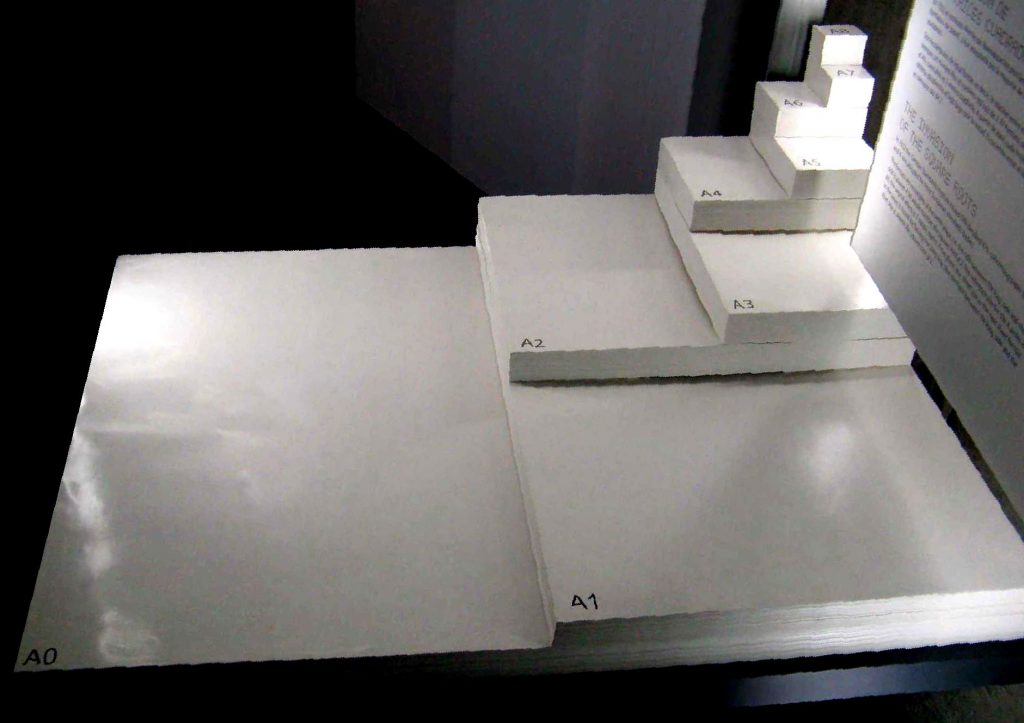
Modell der Papierformate A0 bis A8 in originaler Größe im Science-Museum, Barcelona
photo by Dr.-Ing. S. Wetzel (Analemma at de.wikipedia)
API
API is an acronym for Application Programming Interface, which is a set of protocols that allow apps and software to talk to and interact with each other.
The Stannp platform is built to be fully API compatible, all of the functions of our platform can be accessed with API calls and your private API key. You can find full documentation of our API on our API Support pages.
API calls work in tandem with Webhooks to allow secure two way data traffic between the Stannp platform and your CRM, E-commerce platform, website or other software or application. (See also Webhooks).
B
Bleed Margin
The Bleed Margin is the area of the design outside the Safe Zone that will be cut off after printing to make the mail piece the correct size.
Designs need to be Edge to Edge to ensure the Bleed Margins are filled with your background image, in order to prevent your finished mail piece having a uneven white border when cut.
Bleed Margins are indicated on the Stannp platform by a pink zone around the edge of the mail piece. If your artwork is the correct size to be edge to edge it will show underneath the pink bleed margin, like this;

Correct 
Under-sized Design
If you require a white border around your mail piece you need to upload an edge to edge design that includes a white border, rather than uploading an undersized design.
For more info on Bleed Margins (including a full ‘how to’ guide) please read our post “The Cutting Edge of Direct Mail“. (See also ‘Edge to Edge Design‘ and ‘Trim Marks‘).
BRE
A BRE is a Business Reply Envelope, part of Royal Mail’s Business Reply Plus Service. The BRE encourages Recipients to respond to the mailing you have sent to them by providing a pre-paid, pre-addressed envelope for them to use to send their response back.
BRE users pay an annual licence fee to Royal Mail, and them pay the postage fee for the responses that are received back to their address by recipient’s using a BRE.
Stannp can included a BRE in your mailing if your campaign requires one, either printed by Stannp or provided pre-printed and included during our campaign fulfilment process.
C
C5 Envelope
A C5 Envelope is an ISO 216 standard envelope size, which is 162mm × 229mm. Stannp’s standard envelope size is C5, as this size is designed to take either an A4 letter folded in half or an A5 postcard. We can also offer C4 and DL envelopes if required.
(See also ‘Window Envelope‘, ‘Non-Windowed Envelope’, and ‘Aspect Ratio‘ for more information on paper sizes.)
Clear Zone
The Clear Zone is the area of the mail piece that must be kept clear of design imagery, text etc, in order to allow the mailing to be Machine Sorted.
The clear zone size, shape and position are set by Royal Mail and Stannp are required to meet Royal Mail’s specifications in providing our Direct Mail services.
On the Stannp platform the Clear Zone is shown with pink hatching;
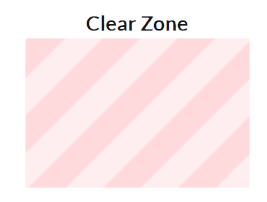
Direct Mail works better if you take the clear zone into account when designing the mailpiece, rather than ‘imposing’ the clear zone onto a pre-existing design. (See also ‘Machine Sort‘).
Coated (paper)
Coated Paper is paper which has been coated with something to change its properties, often this is a thin layer of polymer.
Our standard stock for postcards and greetings cards is 300gsm coated silk card, although you can also opt for uncoated. Silk coating is more shiny than uncoated paper, but not as shiny as gloss coating. (See also ‘GSM’, ‘Uncoated’).
CMYK
In four colour printing processes (e.g. Litho) there are 4 process ink colours, which are applied in different proportions to make up all of the colours in the image. CMYK is an abbreviation for these 4 colours, Cyan (green-blue), Magenta (purple-red), Yellow, BlacK.
Images in a CMYK ‘colour space’ are defined in terms of the proportion of each of these colours in each pixel (see also ‘RGB‘). CMYK printing is also referred to as ‘process colour’ printing.
CSV
A CSV file is a file type where the data is separated by commas, the file is separated into columms using a comma (,) as a field separator. CSV stands for ‘Comma Separated Values’.
Data can be uploaded to the Stannp platform in either CSV or Excel file formats.
CTA /Call To Action
A CTA or Call To Action is the critical message of your mailing.
What do you want your recipient to do when they receive your mailing, and how do you want them to do it?
It might be a simple as a line of text “call now on xxx-xxxxx” or “try for 30 days risk free”, or as complex as “register on our website before 31st July for a 10% discount” or “did you forget to order your xxxxx?” with a specific, targeted image of the abandoned product.
The specific details of your call to action will depend on your sector, your audience, and what you are trying to achieve with the mailing, but the most important point is this;
Without a call to action, your recipients won’t take any action!
D
Dedupe
Dedupeing (short for de-duplication) is the process of identifying and removing duplicate entries from a data set. The Stannp platform offers various dedupe options when uploading data, allowing you to chose from several options how the system identifies duplicates, and what it will do with duplicates when they are found.
Deduping is an important process to ensure that your campaign doesn’t send multiple mail pieces to a single recipient (who may appear on several sets of your address data).
Die Cut
A die is a tool, use to cut or shape material in a press, Usually a die is customised to the specific product it is designed to make, a different product or version will need a different die.
In printing a piece that has been Die Cut means that a formed metal edge die has been used to precision cut a shape into a piece of printed card or paper.
Digital Stamp
Alternative name for PPI. (See also ‘PPI‘).
Digital Print
Digital Print is the colloquial term often used for xerography (as described under ‘Xerox‘ in this Glossary).
Unlike ‘wet print’ methods, Digital Print transfer a digital image directly onto the base media (in the case of Stannp Direct Mail, the media is paper and card).
All Stannp’s printers are Digital, allowing us to provide our customers with shorter turnaround times, no minimum print volumes, and variable data and image printing.
Dispatch Date
The dispatch date of your campaign is the date we will hand over your campaign into the Royal Mail delivery network (via DSA).
When you are ready to send your campaign, in the ‘Booking and Payment’ page of the Stannp campaign wizard you will see a calendar. Any date that has a green triangle in the top left corner is available for you to select as a dispatch date.
When you click on your preferred dispatch date it will be highlighted in yellow, with a white tick in the top left corner. At the same time our system will calculate the expected landing date, and show that on your calendar in grey with a house symbol in the top left corner. (You can see an example of this in the screenshot below).
The expected landing date is calculated as 2 working days after dispatch; Saturday is usually included as a working day as Royal Mail have a Saturday delivery service in most areas. UK Bank Holidays are not included as working days, as Royal Mail do not normally offer a Bank Holiday delivery service. (See also ‘DSA‘ and ‘Landing Date’).
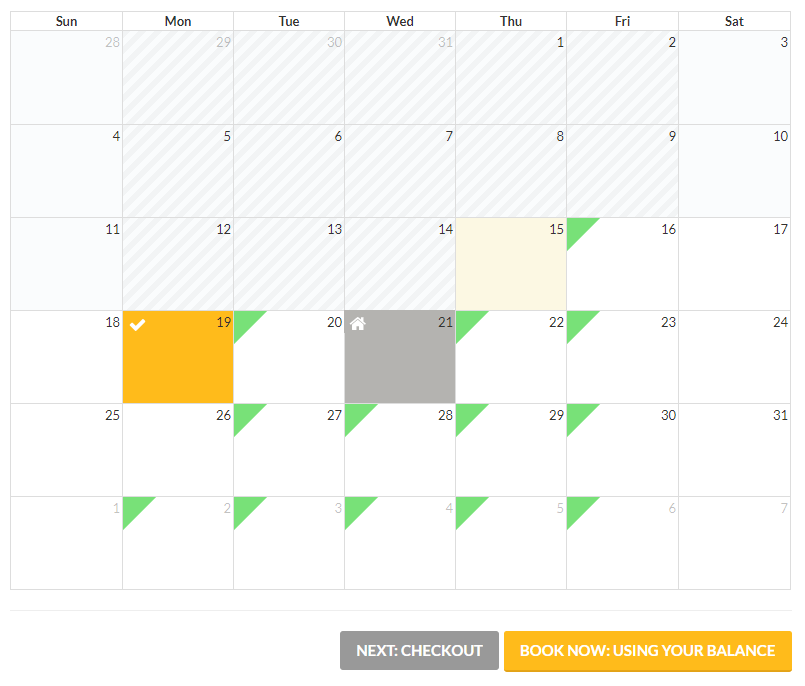
DPI
DPI stands for “dots per inch”, and is used to measure Image Resolution. It is the number of dots that horizontally and vertically into a one-inch square space.
DSA
DSA is an acronym for the phrase ‘Down Stream Access’. Because of our proprietary software pre-sort process that happens at the data merge stage before your Direct Mail is printed, Stannp is able to use DSA to inject your campaign straight into the Royal Mail network.
DSA means Stannp are able to offer you both great value mailing (considerably cheaper than purchasing a stamp) and a speedier service.
Duplex
Duplex is a printers term for ‘double sided’, i.e print on both sides of the paper /card. it’s used in specifications to distinguish from items with print on one side, known as ‘Simplex’ (See also ‘Simplex‘).
Dynamic Field
See Variable Data.
E
Edge to Edge Design
‘Edge to Edge design’ simply means that the background design for your mail piece is large enough to completely fill the dimensions of the template. The best (and easiest) way to achieve this is by uploading artwork that is already at the correct size for the template, which will be 3mm larger on every size than the finished size of your mailing.
for more info on Edge to Edge (including a full ‘how to’ guide) please read our post “The Cutting Edge of Direct Mail“.
F
Foil
‘Foiling’ is the process of covering paper or card with a thin, flexible sheet of usually metallic material (the ‘Foil‘), which is often used to highlight specific details or text on a design. The foil is then stamped, which makes it adhere to the paper in the areas that the foil is required and cuts it away from the rest of the design.
Foiling isn’t available as a standard item on our platform as Stannp don’t produce foiled items in house. However, we work with a number of print partners and are able to provide foiling for custom campaigns; please get in touch with your account manager who will be happy to help you.
G
GDPR
GDPR is an abbreviation for “The General Data Protection Regulation 2016/679“, a European Union regulation which governs the use of personal data. Many countries and states have enacted similar regulations, for example the California Consumer Privacy Act and APEC Cross-Border Privacy Rules.
GDPR is a complicated piece of legislation; if you would like further information about how it effects Direct Mail our article “Does GDPR prevent you sending Direct Mail?” may be useful to you.
Many companies that decided to use ‘consent’ as their lawful basis for data processing found that a large proportion of their customer base chose to ‘opt-out‘ of receiving emails.
However, GDPR doesn’t prevent you from contacting your email opt out customers by post, and many Stannp clients are finding they get good response rates from Direct Mail campaigns encouraging customers to ‘opt-in‘ to email contact again.
(See also ‘Opt-out‘, ‘Opt-in‘ and ‘Response Rate‘)
Gone Aways
‘Gone Aways’ are recipients in your data set that have moved house and are no longer living at the address you have in your data set. Depending on the nature of your mailing you mayor may not prefer to exclude Gone Aways from your mailing.
For example, if you are sending appointment reminders to existing customers you may well prefer not to send to Gone Aways. On the other hand if your mail piece is advertising a local business you might be quite happy to have the mailing delivered to the new residents at that same address, even thought the intended recipient has moved.
Gone Aways are one of the three categories of data reported by Stannp’s Data Healthcheck Service, the others being ‘Deceased’ and ‘MPS Registered”. (See also ‘MPS‘).
GSM
People often confuse GSM with ‘thickness’, but GSM actually stands for Grams per Square Metre, and is a measure of the “substance weight” of the paper, literally how much a square metre size of the paper weighs in grams.
For the same paper type, a heavier weight (higher GSM) paper will be thicker, but two papers of different types (i.e. manufactured in different ways) could have the same GSM rating, but be very different thicknesses and feels very different from each other.
We realise that can all sound pretty complicated, so here are some examples to try and help. Standard printer paper used in most homes and offices is usually 80GSM. The high quality paper Stannp use for your A4 letters is 100GSM, and the card stock we use as standard for A5 & A6 postcards and greetings cards is 300GSM.
H
Hand Sort
Hand Sorting is the process Royal Mail use for addresses that don’t PAF Match, and therefore can’t be machine sorted as the machines cannot read the address. You can see a example of the hand sort process in this film on The Telegraph’s YouTube channel. (See also ‘Machine Sort‘).
House List
A ‘House List’ is an alternative name for 1st Party Data. (See also ‘1st Party Data‘).
I
Indicia
‘Indicia’ is an alternative name for a PPI. (See also ‘PPI‘).
Image Resolution
There are lots of very technical ways to describe image resolution, but in terms of your direct mail campaigns the most important thing to realise about Image Resolution is its effect on the clarity of images in your design.
Images that are ‘low resolution’ may look blurry when printed, as you can see in the example of the three circles below;
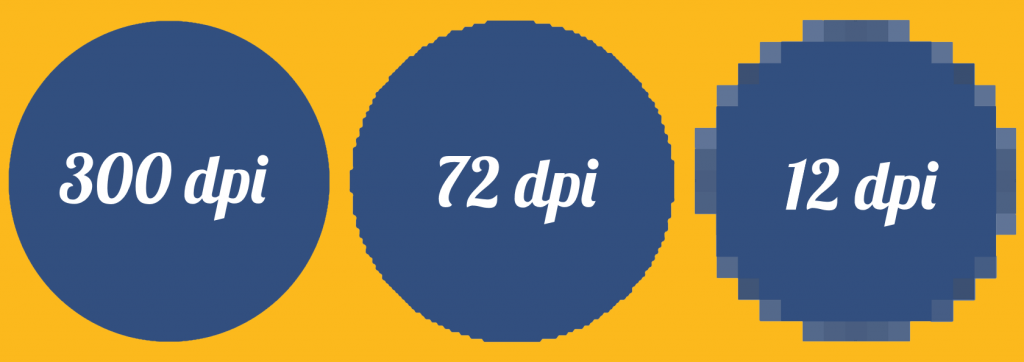
For best results we recommend that images are uploaded at a resolution of 300dpi, to give clear printed images.
When you are in the ‘design mail piece’ section of our wizard, the platform will display the image resolution underneath the design. For example, if your mail piece is an A5 postcard the image resolution (at 300dpi) is 2551 x 1819 pixels. (See also ‘DPI‘).
Insert
An insert is the word we use for any additional (non-personalised) item included in the envelope along with the personalised direct mail piece.
Typical examples would be including a generic brochure, pamphlet, flyer or postcard along with your personalised letter.
J
JPEG
JPEG is an image file format that uses lossy compression to reduce image file size, it stands for ‘Joint Photographic Experts Group’.
JPEG is one of the file formats you can use for images or backgrounds on the Stannp platform.
Junk Mail
Stannp don’t do Junk Mail!
Blanket, un-targeted, generic Junk Mail is the antithesis of the intelligent, personalised, targeted mailings that the Stannp platform is designed to deliver.
Traditional ‘broadcast’ Junk Mail campaigns mean that a significant proportion of your marketing materials are delivered to recipients that are not the people you are trying to reach and don’t have a requirement for or interest in your product or service. This wastage has a detrimental effect on the ROI of your campaigns.
In contrast, Stannp’s Direct Mail enables you to send targeted personalised offers to specific individuals who are already interested in your products or services, giving fantastic returns on your investment.
K
Key
In the context of the Stannp platform a ‘Key‘ is a unique data string rather than a piece of metal you use to open a door!
Every Stannp account has at least one API Key which you can find on your account’s API page; this is your private API key which is use for API driven mailings. Your Private API key is secret and should never be shared or included in public source code such as javascript on websites.
If you believe your private API key has been compromised or shared you should contact Stannp immediately and we will change your key to prevent unauthorised access. You may also like to consider enabling 2 Factor Authentication (2FA).
for certain applications (for example our QR code generator) you may wish to generate a public API key (which are restricted on the Stannp platform to non-sensitive requests). You can generate public API keys on your account’s API page.
(See also ‘API‘, ‘QR Code‘ and ‘2FA‘)
L
Last Mile
The Last Mile is a logistics term for the movement of goods from a transportation hub to the final delivery destination. For Stannp the Last Mile refers to the final delivery of each mail piece, hand delivered by a Royal Mail staff member (or other mail carriers for international campaigns).
Landing Date
The Landing Date is the date we anticipate your campaign will reach the majority of your recipients, which is normally 2 working days after the Dispatch Date. (See also ‘Dispatch Date‘ for a fuller explanation of the process and our definition of ‘working days’ in this context).
Litho
Litho is shorthand for ‘Lithography’, a wet print process where the surface is treated to repel ink everywhere apart from where the print is required.
Modern Lithography is usually an offset print process; this mean the ink is not applied directly from the plate to the paper /card stock, it is first transferred to a flexible sheet (usually rubber) which then transfers the image to the paper.
Litho isn’t available as a standard item on our platform as Stannp don’t produce Litho print in house. However, we work with a number of print partners and are able to provide Litho for custom campaigns, including campaigns with Litho base stock that Stannp then overprints digitally with personalised data and addresses.
for more information on custom campaigns and Litho print please get in touch with your account manager who will be happy to help you.
Lamination
Lamination is the process of applying a thin layer of plastic to paper or card after printing, to protect printed matter. Common types of laminate are gloss, matt, silk and soft touch.
Lamination isn’t available as a standard item on our platform as Stannp don’t laminate in house. However, we work with a number of partners and are able to provide lamination of for custom campaigns; please get in touch with your account manager who will be happy to help you.
M
Machine Sort
Machine Sortation is the process used by Royal Mail distribution centres to sort and deliver mail as rapidly as possible, using machines that can read the postal bar codes that are included with any PAF Matched addresses on your Stannp Direct Mail campaigns.
You can see an example of Machine Sort in action in this film on the Telegraph’s YouTube channel. Where addresses don’t PAF Match they have to be Hand Sorted by Royal mail staff, which incurs an additional charge. (See also ‘Hand Sort‘).
MPS
MPS is an abbreviation of Mail Preference Service. Any individual can register their address with the MPS to indicate that they doesn’t want to receive unsolicited advertising.
It’s important to note this does not prevent them receiving all mail, for example they may have registered with your company as being willing to receive mail (and therefore your mailing would not be ‘unsolicited’), or they may be a customer who you are contacting with some information about their account or transaction(s) with your company (and therefore your mailing isn’t advertising).
MPS registrations are one of the three categories of data reported by Stannp’s Data Healthcheck Service, the others being ‘Deceased’ and ‘Gone Aways“. (See also ‘Gone Aways‘).
N
Naked Mailing
a Naked Mailing isn’t some kind of risqué seaside postcard!
When we talk about a Naked Mailing we mean any mail piece that is not enveloped, the printed item includes the address and PPI and goes into the Royal Mail delivery network as it is.
Examples of naked mailings include A5 postcards, A6 postcards and A5 tabbed greetings cards. Naked Mail is sometimes also referred to as a ‘Self-Mailer‘ (because it doesn’t require an envelope).
Non-PAF (Non- matched)
See definition for PAF Matched.
Non-Window Envelope
A Non-Window Envelope is an envelope that does not have a window in it to to allow the document inside to show through.
When using non-window envelopes the delivery address is not printed on the mail piece, the address and must be printed directly on to the envelope. (See also ‘C5 Envelope‘ and ‘Window Envelope‘)
O
Offset Printing
See ‘Litho‘.
Open Rate
Open Rate is a measure of campaign effectiveness, used for many campaign types, including email marketing and direct mail. It measures the percentage of items sent from a campaign that are actually opened by the recipients.
Research shows that more than 92% of Direct Mail is opened, in fact for a Naked Mailing opening rates are effectively 100%.
This compares favourable to email open rates, which peak at between 20% and 30% depending on which study you look at.
Opt-In
Opt-In (in the context of ‘GDPR) is the act of granting a company permission (‘consent’) to send you emails, allowing your email address to a mailing list.
Opt-Out
Opt-Out (in the context of ‘GDPR) is the act of withdrawing or declining a company permission (‘consent’) to send you emails, excluding your email address from a mailing list.
P
PAF Match /PAF Matched
Our platform automatically cleans address data as it is uploaded and verifies the addresses against the Royal Mail Postal Address File, or PAF File. Addresses that match the data in the PAF are ‘PAF Matched‘.
PAF Matched addresses can be machine sorted by Royal Mail and receive the maximum postal discount available (which we pass on to you, our customers). Addresses that don’t PAF match can usually still be sent, but incur an additional cost as they have to be hand sorted by Royal Mail staff.
a PDF is a file designed for easy sharing between different devices as it includes the document layout in the structure. PDF stands for Portable Document Format.
Postal Imprint
Postal Imprint is another name for Indicia or PPI. (See PPI).
PPI
PPI (in the context of Direct Mail) is a Royal Mail abbreviation for Printed Postage Impression. This is the symbol you will see printed near the address on your postcards and on the top right hand corner of envelopes, in place of a stamp.
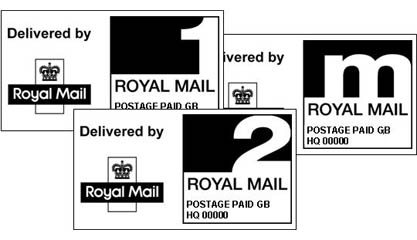
The PPI demonstrates to Royal Mail that postage has been paid (filling the same royal as a stamp), and also allows the item(s) to be tracked back to Stannp. a PPI mark is also sometimes know as a ‘Digital Stamp‘ or ‘Indicia‘.
Print Smears /Print Smearing
See ‘Roller Burn‘.
Proof
A Proof is a preliminary version of a printed piece, usually used to give a customer a close representation of how the piece will appear when printed. The Stannp platform generates a PDF Proof of your mail piece at the ‘Review and Approve’ stage, using a sample of your own data to show how the mailing will look when printed. (See also ‘PDF‘).
Process Colour
for Process Colour see ‘CMYK‘.
Q
QR Code
A QR code is a square image that looks and functions in a similar way to a bar code, and looks like this;

QR is an abbreviation of Quick Response Code, they are useful for driving traffic from your offline mailing campaign to an online presence (website, video, social media etc).
Stannp has an API QR code generator available for all of our customers to use (free of charge) to generate API codes ‘on the fly’ for your direct mail campaigns.
R
Recipient
the Recipient is the person who receives your mailing. Ideally this will be the intended recipient! (i.e. the person who’s name is on the mailing). Using Stannp’s Data Cleaning Service and removing ‘Gone Aways‘ from your data will help to reduce the number of unintended recipients for your campaigns. (See also ‘Gone Aways’).
Return Address
The Return Address is used to indicate to the mail carrier and /or the recipient how to return the mail if it is undeliverable, miss-addressed or unwanted.
It’s a requirement from Royal Mail that all mail you send through Stannp.com includes a return address; this can be your own address, or alternatively returns can be addressed to Stannp.
Response Rate
The Response Rate is the percentage of responses received from a campaign. Research by the Direct Marketing Association indicates that Direct Mail response rates are around 4.4% (i.e. around 44 responses for every 1,000 mail pieces sent).
This compares favourably to other marketing channels, for example the same research suggests that you can expect about a 0.12% response rate from an email campaign (just over 1 response per 1,000 emails sent).
RGB
RGB is a additive colour model, where each pixel of an image is described in terms of the proportion of Red, Green and Blue in that pixel.
Each level is represented by the range of decimal numbers from 0 to 255, equivalent to the range of binary numbers from 00000000 to 11111111, or in hexadecimal 00 to FF. This gives over 16 million possible colours. (See also ‘RGB‘).
Roller Burn
See ‘Scuff Marks‘.
S
Safe Zone
The Safe Zone is our term for the area of your mail piece that is well inside the Bleed Margin, at least 3mm further inside the mail piece than the position of the Trim Marks.
Any text or images in this area are far enough away from the edge of the mail piece that they are in no danger of being in the area of the mail piece that may be cropped off during the cutting process (and are therefore ‘safe’). On the Stannp platform the edge of safe zone is indicated by a green dashed line border.
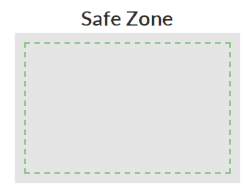
Scoring
Scoring is the process of using a machine or a hand tool to press a channel into a sheet of paper or card, to allow it to fold more easily and accurately. folding along a score will do less damage to a printed surface than an un-scored fold, and is less likely to cause ‘cracking’ of the print.
Scuff Marks
Very occasionally a mail piece passing through the Royal Mail delivery network will receive some damage during the handling process, similar to that shown in the image below;
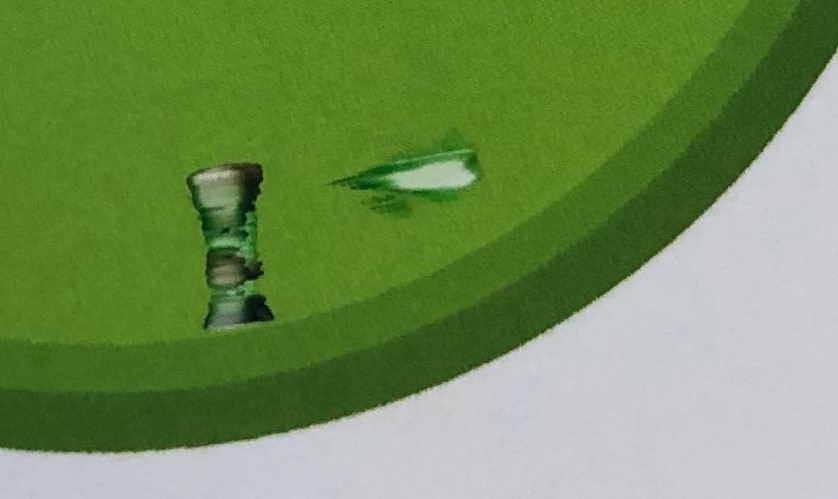
Initially you might think this is a ‘Print Smear‘ caused during the printing process, however all of Stannp’s printing processes are xerographic; there is no wet ink in our printing process, only dry toner that is instantaneously fused to the paper at the point of printing.
These marks are actually caused by the rollers and belts in the automated sorting machines used in Royal Mail’s sorting centres, where each machine is sorting thousands of items of post an hour using machine readable, PAF Matched addresses.
Depending on how far the mail piece has to travel it may go through several sorting offices and several machines. Occasionally a specific machine will have been set in such a way that is the rollers or belts will apply too much pressure to the mail piece, gripping the piece too tightly and penetrating the toner, causing a Scuff Mark. This is the reason the marks are sometimes referred to as ‘Roller Burn‘.
Seed
A Seed is an address (or sometimes several) in data set that will sent the mail piece to you, the originator of the campaign.
at Stannp we recommend you ‘seed’ the data sets for all of your campaigns, so you receive exactly the same mailing at the same time as your recipients.
Self-Mailer
See ‘Naked Mail‘.
Simplex
Simplex is a printers term for ‘single sided’, i.e print on only one side of the paper /card. it’s used in specifications to distinguish from items with print on both sides, known as ‘Duplex’ (See also ‘Duplex‘).
Spot Colour
A Spot Colour is a single colour (or sometimes several colours) applied to a printing process either instead of process colour (CMYK) printing, or in addition to process colour printing to add a specific specialised ink (fluorescent, metallic etc).
Spot Colour is often used where either a design calls for only a very few colours, or where colour accuracy is critical and a specific premixed ink colour is used to ensure colour match is achieved.
Spot Lam /Spot Lamination
See ‘UV Coating‘.
Suppression
in the context of Direct Mail suppression is the act of removing specific recipients from a campaign before it’s sent.
Stannp’s Data Health Check service allows you to check your recipient data for Gone Away, deceased, and MPS Registered recipients, and decide which (if any) of these groups of recipients you would like to suppress.
T
Trim Marks
Trim Marks are used by the Stannp team to line items up in our guillotines after printing, as guidelines to aim at for cutting your mail pieces to the correct size. (see also ‘Edge to Edge Design‘ and ‘Bleed Margin‘).
U
Un-Matched
Addresses that don’t PAF Match (see ‘PAF matched’ for more details).
Un-Coated
Paper that has not been coated and is in its ‘raw’ finished state. Un-coated paper tends to be more absorbent than coated paper stocks. (See also ‘Coated (paper)‘).
UV coating
UV Coating is a glossy shiny liquid coating applied after printing. UV is short for Ultra Violet; the process is called UV Coating because the liquid coating is cured (set to a hard finish) with ultra-violet light after it is applied.
UV Coating gives a very high shine finish, and is often used over a dark colour print like black or dark blue, giving an ‘almost liquid’ looking finish. It can be particularly effective for giving extra emphasis and making details ‘pop’ out from a design, so it often gets used on logos and images within a design.
UV coating also gives good abrasion resistance, great for protecting your ‘Naked Mailing‘ as it travels through the delivery network.
‘Spot UV‘ refers to the UV coating applied in specific areas of a design rather than coating the whole surface, in a similar way to a Spot Colour application. Spot UV is sometimes referred to as ‘Spot Lam /Spot Lamination‘, which strictly speaking isn’t accurate as it’s not a lamination process.
V
Variable Data
One of the key features of personalised direct mail with Stannp is Variable Data. Our platform allows you to vary any element of your design including both text and images, using simple variable data fields.
That variable data fields (also known as ‘Dynamic Fields‘) match the headings of the data you’ve uploaded, and are included by putting the name of the field in curly braces {}. For example {firstname} will insert the recipient’s first name.
W
Webhooks
Webhooks work hand in hand with our API just in the opposite direction!
They allow you to extract certain types of information from the Stannp platform and post it into your own systems, by subscribing to events. When the event happens (for example a specific mail piece is dispatched) the Webhook triggers a notification to your subscribed system. (See also API)
You can find more information about Stannp Webhooks in our How To Use Webhooks Guide.
Window Envelope
A Window Envelope is an envelope that is manufactured with a see-through film or plastic window in a specific standard position in the envelope, allowing the portion of the mail piece that is behind the window to show through.
A window envelope is normally used for documents that have the address details included in the document, typically an A4 letter folded into a C5 windowed envelope. (See also ‘C5 Envelope‘ and ‘Non-Window Envelope‘)
X
Xerox
Xerox is a company that produces high quality printers that produce print using the process commonly known as ‘laser printing’, but is more correctly called ‘electrostatic digital priting’, ‘electrophotography’, or ‘Xerography’.
Chester Carlson invented the process of Xerography (which literally translates as ‘dry writing’, as opposed to other ‘wet ink’ printing processes) in 1938, and founded the Xerox company.
All of Stannp’s printers are high quality, high volume Xerox digital printers. (See also ‘Digital Print‘).
Y
York
A York is the Royal Mail term for the Cage Trolleys that are used to transport mail from Stannp to our DSA partners, and on into the Royal Mail distribution network.
York’s are specifically designed to take 28 Royal Mail standard letter trays, stacked in 4 columns of 7 trays.(See also ‘DSA‘).
(Yep you are right, we were struggling to find a glossary term for Y!)
Z
Zip Code
a Zip Code is the numerical code, usually shown after ‘state’ in an American postal address, that functions as a Post Code for addresses in the USA.
Stannp is USPS CASS certified, which means that the United States Postal Service have certified that our platform handles US addresses and Zip Codes correctly, giving you pinpoint accurate postal service throughout the United States.
We hope you’ve found our Glossary useful. Don’t forget, for more useful hints tips and info find us on Twitter, Facebook and LinkedIn, and speak to your account manager.






